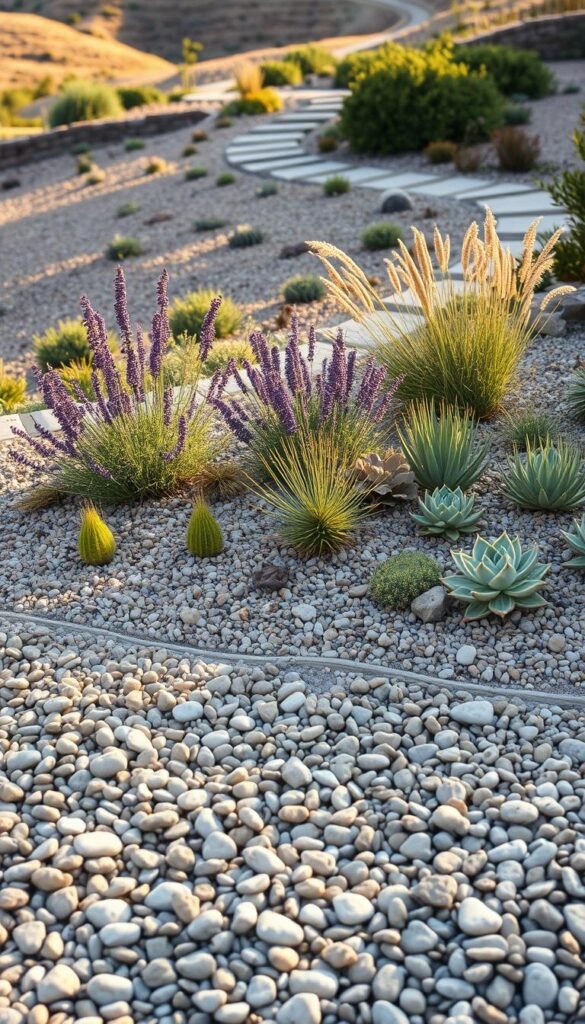Outdoor spaces are getting a major upgrade in 2025, with rock-based landscaping surging 504% in popularity. Homeowners nationwide are embracing this approach for its blend of beauty and practicality. Unlike traditional lawns, these designs thrive with minimal watering and adapt to both sunny yards and shaded corners.
What makes these spaces special? They combine textural contrast with drought-resistant plants like sedums and alpines. You’ll find clever combinations of stone varieties working alongside low-maintenance plants that bloom in vibrant colors. This creates visual interest without demanding constant care – perfect for busy schedules or gardening newcomers.
From modern minimalist layouts to rustic cottage charm, these adaptable designs prove functionality doesn’t sacrifice style. They handle intense sunlight through strategic plant selection while using mulch layers to reduce weeding. Even urban dwellers can create striking displays using self-watering containers and smart grouping techniques.
Ready to reimagine your yard? Discover 16 creative approaches that balance contemporary aesthetics with earth-friendly practicality. Whether you’re crafting a serene retreat or an entertainment-ready area, these solutions work smarter – not harder – for lasting impact.
Unlocking the Unique Benefits of a Gravel Garden
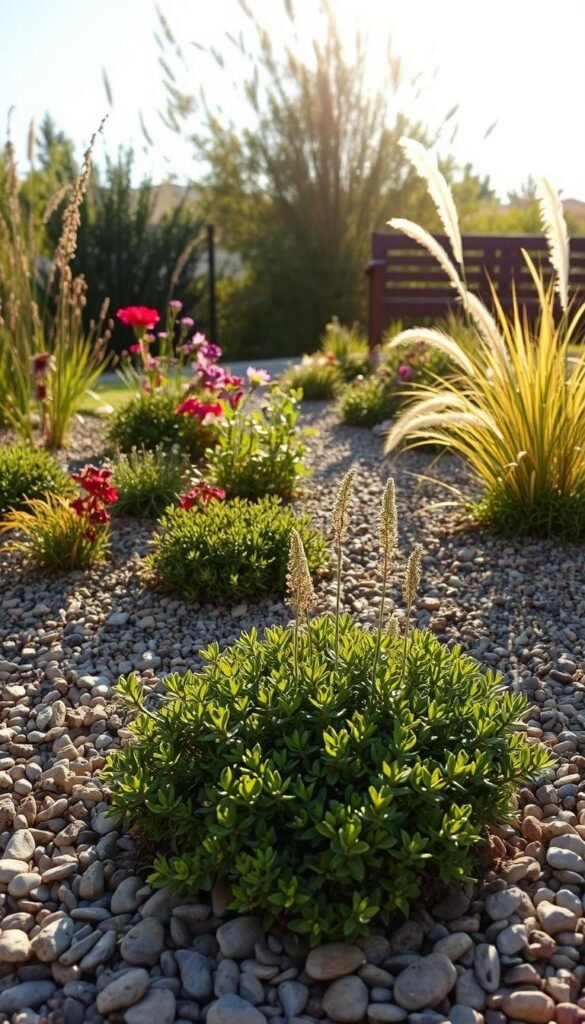
As weather patterns become unpredictable, gardens need designs that adapt effortlessly. Gravel-based landscapes offer a smart solution, balancing durability with natural charm. They work like a sponge, managing water flow during storms while storing moisture for dry spells.
Why Choose This Approach?
Traditional lawns struggle in extreme conditions, but gravel surfaces stay resilient. The stones act as a thermal blanket, protecting plant roots from scorching heat and frost. This setup reduces maintenance by up to 70% compared to grassy yards, according to landscape experts.
Smart Water Management
Gravel’s permeable nature solves two problems at once. During heavy rains, it prevents flooding by improving drainage. In droughts, it locks in soil moisture, cutting watering needs by half. Pair it with drought-tolerant plants, and you’ve got a self-sustaining ecosystem.
These spaces also support permaculture gardening principles, fostering biodiversity without constant care. You’ll spend less time weeding and more time enjoying your outdoor retreat. Plus, gravel naturally suppresses pests, creating a healthier environment for plants to thrive.
Understanding Gravel Types and Sustainable Choices
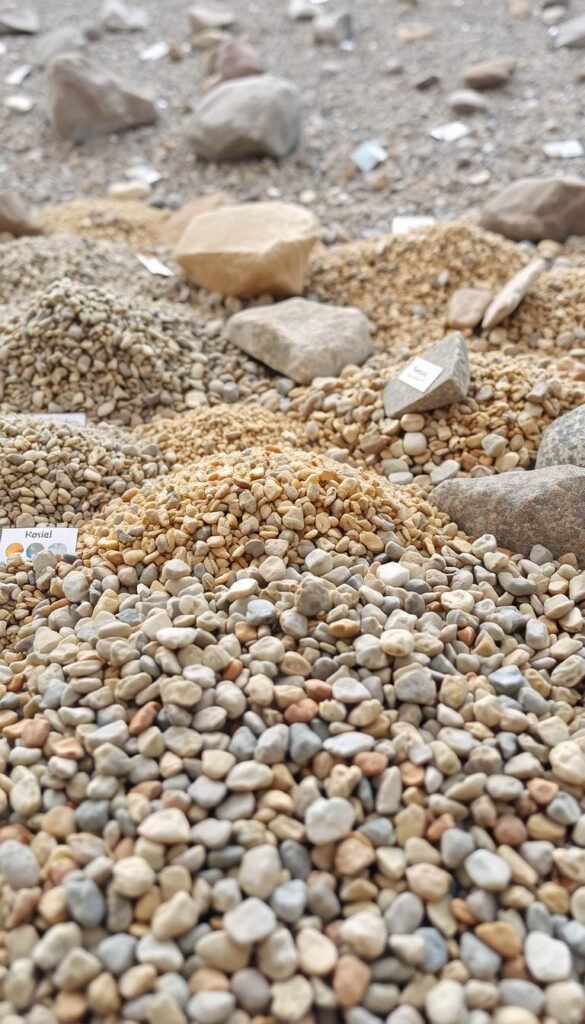
Your stone selection shapes both your landscape’s performance and environmental impact. The right gravel balances practicality with visual harmony, creating spaces that work as hard as they look good.
Choosing the Right Size and Texture
Smaller stones stay put better. Aim for pieces under 10mm – they lock together like puzzle pieces, reducing migration. Pea gravel shines here, offering a smooth surface that’s gentle on bare feet and paws.
Depth matters as much as size. A four-inch layer:
- Allows proper water drainage
- Supports plant roots
- Maintains consistent appearance
“Texture defines your garden’s character – rough stones create drama, while rounded ones invite relaxation.”
Sustainable Sourcing and Recycled Options
Eco-friendly choices start with ethical suppliers. Look for Ethical Stone Register certification to avoid environmentally damaging practices. Steer clear of seabed-dredged materials that harm marine ecosystems.
| Material | Size Range | Eco Rating |
|---|---|---|
| Crushed Concrete | 5-10mm | ★★★★☆ |
| Reclaimed Brick | 8-12mm | ★★★★★ |
| Local Granite | 6-9mm | ★★★☆☆ |
Recycled options like crushed concrete offer surprising versatility. They come in warm earth colors that blend naturally while keeping construction waste out of landfills. Local sourcing cuts transportation emissions – a win for your budget and the planet.
Planning Your Gravel Garden Layout for Maximum Appeal
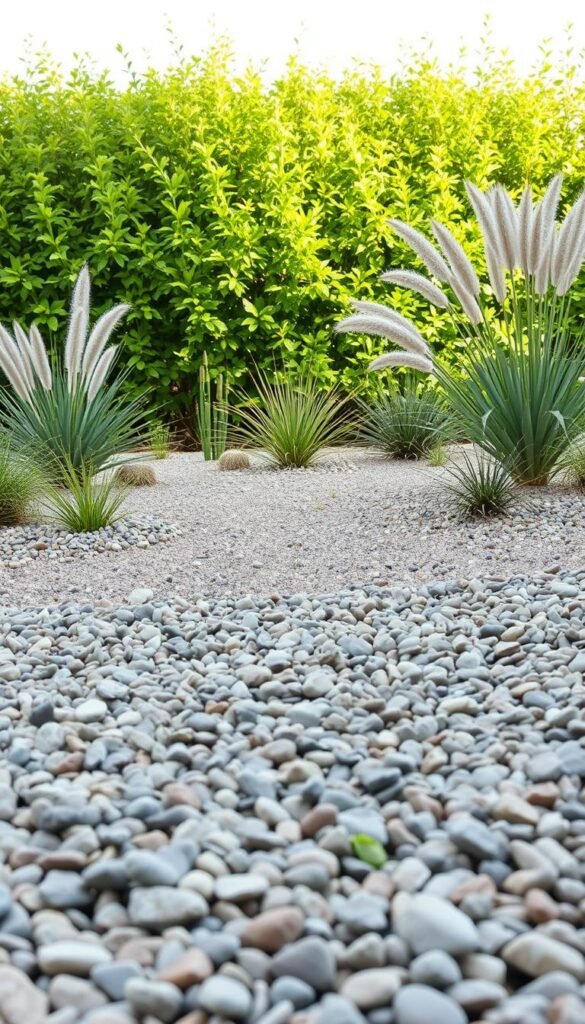
Effective layout planning turns a simple gravel space into a dynamic landscape. Start by mapping out functional areas that serve different purposes – think relaxation spots, walking paths, and plant displays. This approach boosts visual rhythm while making your outdoor area more usable.
Creating Distinct Zones
Divide your garden using contrasting stone sizes. Larger river rocks work beautifully around seating nooks, while crushed granite defines walkways. For extra drama, try dark basalt pebbles around light-colored boulders. This creates natural borders without fences or walls.
Reclaimed materials add personality to edges. Old barn wood separates herb areas from pathways, while buried wine bottles create whimsical borders. “Zoning transforms empty spaces into purposeful destinations,” notes landscape architect Eli Martinez.
Integrating Pathways and Edging Details
Curved walkways guide eyes through your design. Use 10mm gravel for main routes and 5mm chips for secondary paths. Stepping stones break up the texture, creating visual pitstops. Edging keeps stones contained and adds polished contrast.
Try these combos:
- Weathered railway sleepers with pea gravel
- Mosaic tile borders alongside crushed slate
- Rusted metal strips bordering golden limestone
Smart zoning lets every part of your garden shine while maintaining effortless flow. You’ll create intrigue at every turn without overwhelming the senses.
Inspiring Gravel Garden Ideas for a Low-Maintenance Landscape
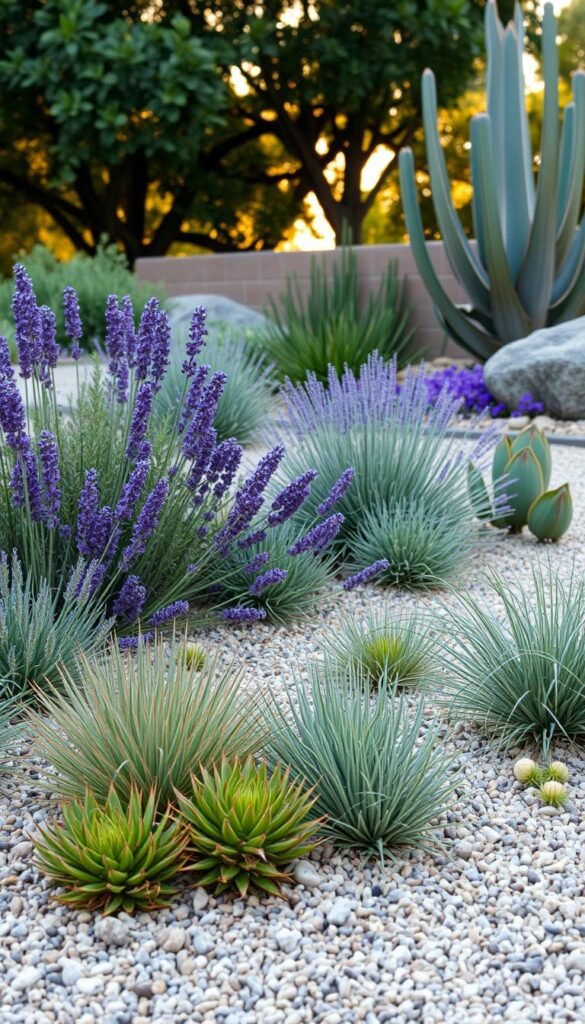
Transform your yard with creative approaches that fit any lifestyle. Whether you’re refreshing a corner or overhauling your entire outdoor space, gravel offers endless possibilities. Start small with decorative strips between pavers or go bold with stone-filled planters – both options keep upkeep minimal while adding modern flair.
Even compact areas shine with strategic stone placement. Frame a cozy seating nook with crushed limestone, or craft winding pathways using mixed pebble sizes. These textured elements guide the eye without overwhelming the senses. For larger yards, consider geometric patterns using contrasting gravel colors – charcoal basalt against ivory quartz creates striking visual depth.
Plants thrive in these settings when paired properly. Drought-resistant succulents pop against smooth river rocks, while ornamental grasses sway gracefully through coarse granite chips. “The secret lies in balancing stone mass with airy foliage,” advises designer Lauren Kessler. This harmony reduces watering needs by 40% compared to traditional beds.
Adapt these ideas to your climate and space constraints. Urban balconies benefit from self-contained gravel trays with alpine plants, while sprawling properties can feature stone “rivers” flowing between native shrubs. Every design choice prioritizes ease – less weeding, no mowing, and more time enjoying your personalized retreat.
Designing a Rock Garden: Texture and Depth
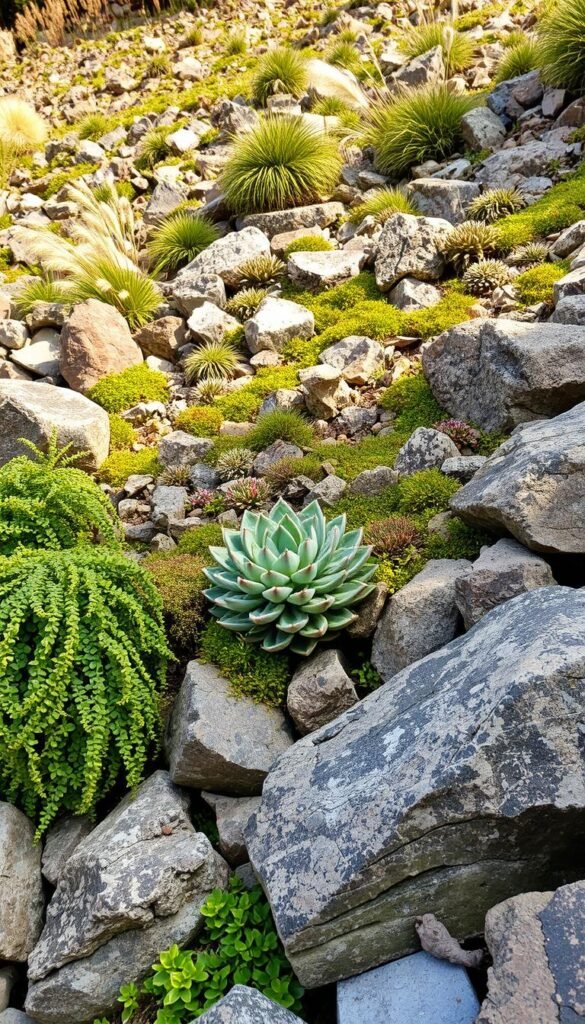
Elevate your outdoor space with layered stone arrangements that mimic nature’s artistry. Strategic placement of different-sized rocks creates visual movement while solving practical challenges like erosion control. This approach works particularly well in areas with natural slopes, where gravity becomes your design partner.
Mastering Stone Placement
Start with anchor boulders – these 18-24″ showstoppers establish your layout’s backbone. Bury them one-third into the ground for stability and authenticity. Smaller stones then cascade downward, creating natural-looking scree slopes that improve drainage.
| Stone Type | Size Range | Best Use |
|---|---|---|
| Granite Boulders | 18-24″ | Focal Points |
| Sandstone Slabs | 12-18″ | Terracing |
| River Rocks | 6-12″ | Pathways |
| Crushed Limestone | 1-3″ | Ground Cover |
Alpine Plant Pairing Strategies
Miniature varieties thrive in rocky conditions. Blue-eyed grass adds delicate charm between stones, while wild tulip species bring unexpected color pops. For year-round interest, try evergreen sedums that cascade over ledges.
Tuck primulas into north-facing crevices where they’ll enjoy afternoon shade. “The magic happens when blooms appear to grow straight from stone,” notes Colorado landscaper Tara Winslow. This illusion creates that authentic mountain vibe without the altitude.
Combine jagged stone edges with soft moss varieties to amplify texture contrasts. Your rock garden becomes a living sculpture that evolves beautifully through seasons, demanding little beyond occasional debris removal.
Crafting a Tranquil Zen Garden
Transform your backyard into a meditation-ready oasis using nature’s simplest elements. Pale gravel acts as your blank canvas, raked into flowing patterns that mimic water ripples. This style thrives in shaded areas where soft mosses creep between stones, creating living art that evolves daily.
Minimalist Designs and Water Features
Less truly becomes more in these spaces. Position angular boulders as focal points, then surround them with fine 3mm gravel. Add a bamboo water spout or shallow pond to introduce calming sounds. The trick? Keep designs asymmetrical – nature rarely follows strict symmetry.
Choosing the Perfect Plants for Balance
Select foliage that complements stone textures without overwhelming them. Dwarf pine trees add vertical structure with fragrant needles, while Japanese maples provide fiery autumn color. “Groundcovers like saxifrage create velvet-like mats between rocks,” notes Portland designer Kai Nakamura.
Moisture-loving species thrive in zen settings. Plant delicate ferns near water elements and cluster hepaticas in stone crevices. These choices maintain visual harmony while supporting low upkeep – just occasional debris removal and seasonal pruning.
Creating a Mediterranean-Inspired Herb Garden
Imagine stepping outside to the aroma of sun-warmed herbs and the crunch of golden stones underfoot. This style transforms your home into a sensory retreat that’s both beautiful and functional. By combining heat-loving plants with rustic materials, you’ll craft a space that feels straight from a coastal Italian villa.
Herbs That Thrive in Gravel Settings
Mediterranean herbs adore gritty, well-draining soil. Thyme sprawls beautifully between stones, releasing fragrance when brushed. Rosemary’s woody stems add structure, while oregano spills over edges in fragrant waves. These plants evolved in rocky hillsides – they actually prefer lean conditions over rich dirt.
For vertical drama, plant bronze fennel or feathery yarrow. Their tall silhouettes catch sunlight, creating dappled shade for lower-growing varieties. “Gravel acts like a solar blanket,” notes herb expert Luca Ricci. “It stores daytime heat, protecting roots during cool nights.”
Using Terracotta and Reclaimed Materials
Chipped pots and aged bricks add authentic character. Hunt flea markets for weathered planters – their patina tells stories. Whitewashed walls reflect sunlight, boosting growth while keeping your garden bright. For pathways, mix golden gravel with salvaged stone slabs.
Try these combos:
- Crushed terracotta pieces as mulch around sage bushes
- Reclaimed window frames as climbing supports for nasturtiums
- Rusted iron gates as backdrops for lavender hedges
By following Mediterranean garden design principles, you’ll create a self-sufficient oasis. Your herbs stay healthier in gravel’s drainage, and you’ll harvest flavors just steps from your kitchen door.
Developing a Functional Garden Path and Walkway
Crafting pathways that guide exploration transforms how you experience your outdoor space. Gravel’s adaptability lets you shape curves that complement existing features, while strategic planting turns functional routes into visual journeys.
Artistic Patterns Underfoot
Mix materials for striking contrasts. Rustic clay stepping stones add earthy charm between crushed pebbles, while geometric mosaics using charcoal and ivory stones create modern flair. Alternate smooth river rocks with angular granite chips to boost texture underfoot.
Sturdy Foundations Matter
Prevent shifting with proper preparation. Dig 4-inch trenches lined with landscape fabric, then add compacted base layers. Metal or stone edging keeps pathways crisp. For stability, use angular stones that interlock naturally.
Leave intentional gaps between slabs to host drought-tolerant blooms. Erigeron’s daisy-like flowers soften stone edges, while rock soapwort spills over walkways with pink blossoms. These touches turn practical paths into living art that evolves through seasons.

